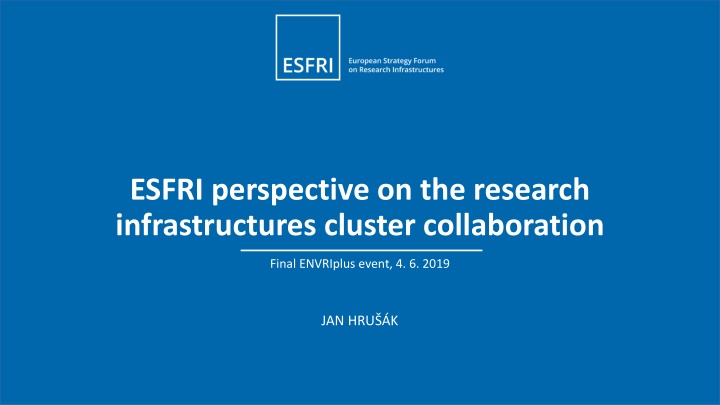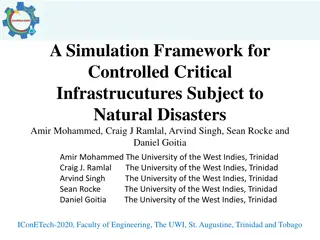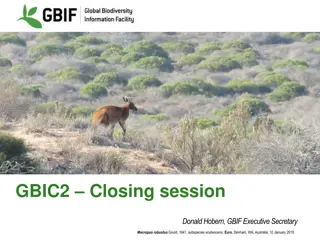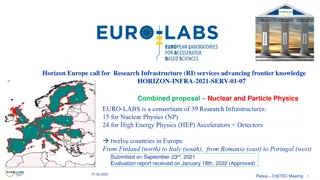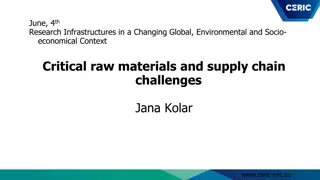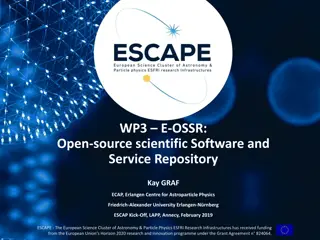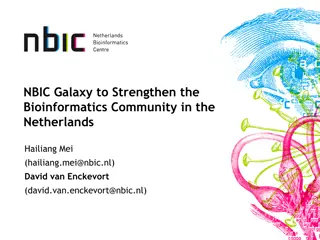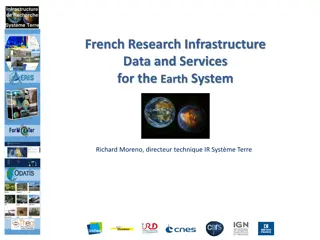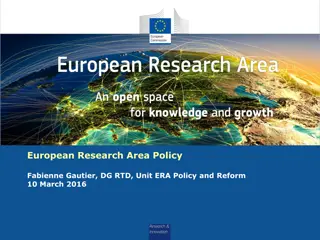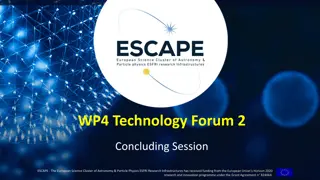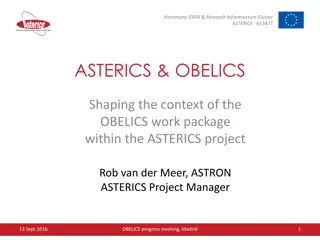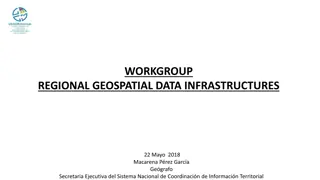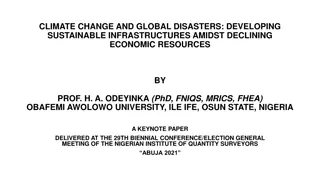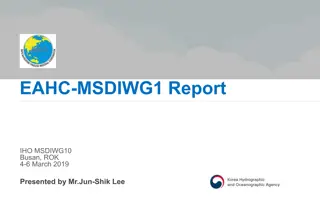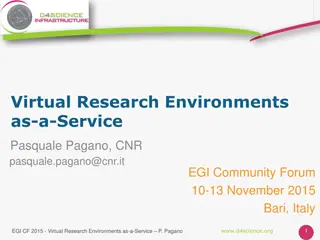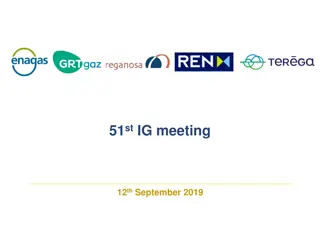ESFRI Perspective on Research Infrastructures Collaboration
ESFRI, established in 2002, aims to support policy making, facilitate initiatives, and establish a European roadmap for Research Infrastructures (RIs). The Landscape Analysis highlights interconnections among RIs, while ESFRI's role as a facilitator involves gap analysis, incubator role, and promoting good practices. The European RI eco-system benefits from collaborative efforts to reduce overlaps and enhance coordination. ENVRI serves as a valuable tool for self-organization within Environmental RIs, fostering opportunities for collaboration.
Download Presentation

Please find below an Image/Link to download the presentation.
The content on the website is provided AS IS for your information and personal use only. It may not be sold, licensed, or shared on other websites without obtaining consent from the author.If you encounter any issues during the download, it is possible that the publisher has removed the file from their server.
You are allowed to download the files provided on this website for personal or commercial use, subject to the condition that they are used lawfully. All files are the property of their respective owners.
The content on the website is provided AS IS for your information and personal use only. It may not be sold, licensed, or shared on other websites without obtaining consent from the author.
E N D
Presentation Transcript
ESFRI perspective on the research infrastructures cluster collaboration Final ENVRIplus event, 4. 6. 2019 JAN HRU K
Main objectives of ESFRI The European Strategy Forum on Research Infrastructures (ESFRI) was established in 2002 with a mandate from the Council of the European Union to: Support approach to policy making on RIs in Europe a coherent and strategy-led Facilitate multilateral initiatives leading to better use and development of research infrastructures Establish a European Roadmap for RIs
The Fifth ESFRI Roadmap and Strategy Report 2006 2008 2010 2016
Landscape analysis The Landscape Analysis gives evidence of the interconnections among the RIs contributing new knowledge in a complementary way. The RIs while maintaining their own disciplinary- rich diversity portfolio, have a high potential to horizontally coordinate on science topics that are addressed only by adopting multiple diverse complementary techniques. Survey and analysis of domain, of the operational international research infrastructures open to European scientists and technology developers through peer-review of competitive science proposals. Identifies the existing resources, the gaps and the potential evolution of each field in the foreseeable future. Monitoring of implemented RIs (landmarks) Coordinatinon in HPC and data infrastructures (under discussion - WG Digit) the context, in each national or
Role of ESFRI as Facilitator In January 2019 ESFRI has started a reflection on the new challenges which will refine a strategy for future shaping of ESFRI. Advising body of the competitivness council Future ESFRI Roadmaps including gap analysis and Landscapes Incubator role in the setting-up of the RIs across the entire lifecycle Structuring role at thematic level by fostering consolidation of European RI eco-system Contribute on request to RI related areas, e.g. addressing societal challenges and SDGs from RI policy perspective Represent EU RIs at international level and Helpdesk for national processes Help promote good practices in RI related agendas and policies Deals with Horizontal issues (e.g. Long-term sustainability study, Missions ) Relationship with EOSC Support emerging sectorial initiatives (LEAPS, LENS, .)
ENVRI as an excellent tool for self-organization Environmental RIs Opportunities for collaboration of EUROPEAN RI ECO-SYSTEM A federated approach should help to reduce overlaps, to maximise synergies and benefits, and to coordinate RIs Efficient strategies within and across scientific domains. Thus accelerating high-quality research and leading to greater sustainability Three interdependent technological capital, cultural capital and human capital are needed to develop and achieve that vision of interconnectedness resources, that of
Self organization RI - Horizontal across fields - Vertikal - structuring effect Rationale for clustering of RIs Multiple perspectives for generating unique and creative solutions Better services to users and scientific cummunities Global competitivness of European research through international collaboration Better diffusion of scientific and technological knowlege Sharing of best practices in management and/or technological solutions Cost effectiveness in purchase - Cost savings Access to broader range of trustable data Better respond to societal challenges SDGs Visibility and societal acceptance Public procurement issues
Clustering of environmental RIs COLLABORATIVE RESEARCH AND SERVICES TO USERS AND SOCIETY Tackling environmental challenges is crucial for mankind and for life on Earth Combining research in individual domains enhances the knowledge about our planet, and these synergies often save time and resources ROLE OF EUROPEAN RIS IN THE GLOBAL LANDSCAPE Global and require global cooperation. Building up on large experience in Europe in collaborative reseach, structured RI organization and on datasharing. Role model and good practice example ENHANCING SOCIETAL IMPACT ENV RIs have significant impact in preservation of wealth. Outreach and enlarged visibitilty of Research and RIs in general. BENEFITING FROM ENHANCED SYNERGIES IN MANAGERIAL AND ECONOMIC TERMS Sharing of knowledge, best practice examples (managerial, technological, legal ...), Technology co-development, Public procurmentpractices, joint tenders
Future Challenges Is ENVRI EOSC ready? Excellent research is more and more based on diverse data sources oriented to study the same phenomena (multimessenger approach already adopted in ENV and H&F RIs) RI clusters as enablers interdisciplinary or multidisciplinary research Knowledge-based society addressed by open data concept High quality data which are FAIR and Reproducible (accessible different disciplinary domains) of ex-ante to users form
Future needs in atmosphere and hydrosphere The Landscape Analysis published in 2018 identified several gaps, challenges and future needs in the area of Environment: Cross-domain Effect of air pollution on children s health should be better explored Societal Science-based assessmend criteria to evaluate the impact of human activities on environmental status shall be better known
Future needs in biodiversity and geospehre The taxonomic gap needs to be overcome, in order to discover and describe the of the biodiversity still to be known. Genetic sequencing and ICT (including big data analysis and digitalisation) New RIs and data are urgent in the fields of geo-resources and mining, in order to achieve meaningful targets of energy and mineral security in Europe MANY others .....
Thank you Final ENVRIplus event, 4. 6. 2019 Jan Hru k
The Roadmap Strategic report Upon mandates of EU Competitiveness Council ESFRI has completed the ESFRI Roadmaps 2006, 2008, 2010, 2016, and the ESFRI Roadmap 2018. The Roadmap identifies new pan-European Research Infrastructures and the evolving role of RIs, corresponding to the needs of European research communities in the next 10 to 20 years, in all fields of research identifies the ESFRI Landmarks that are implemented projects leading in their domain and structuring the European and global landscape. indicate strategies for the necessary major financial investment (~20 b ) and long term commitment for operation (~2 b /year). deals with LTS and innovation oriented approaches, Landscape Analysis Survey and analysis of the context, in each domain, of the operational national or international research infrastructures open to European scientists and technology developers through peer-review of competitive science proposals. Identifies the existing resources, the gaps and the potential evolution of each field in the foreseeable future. Monitoring of implemented RIs (landmarks) Coordinatinon in HPC and data infrastructures (under discussion - WG Digit)
